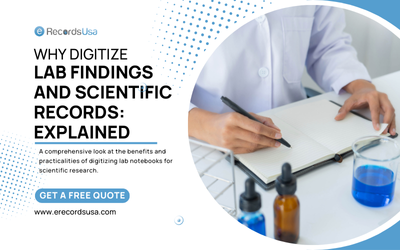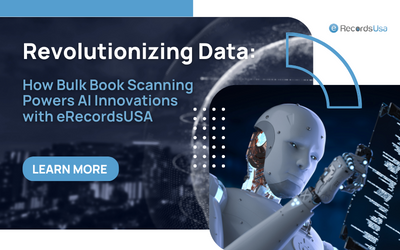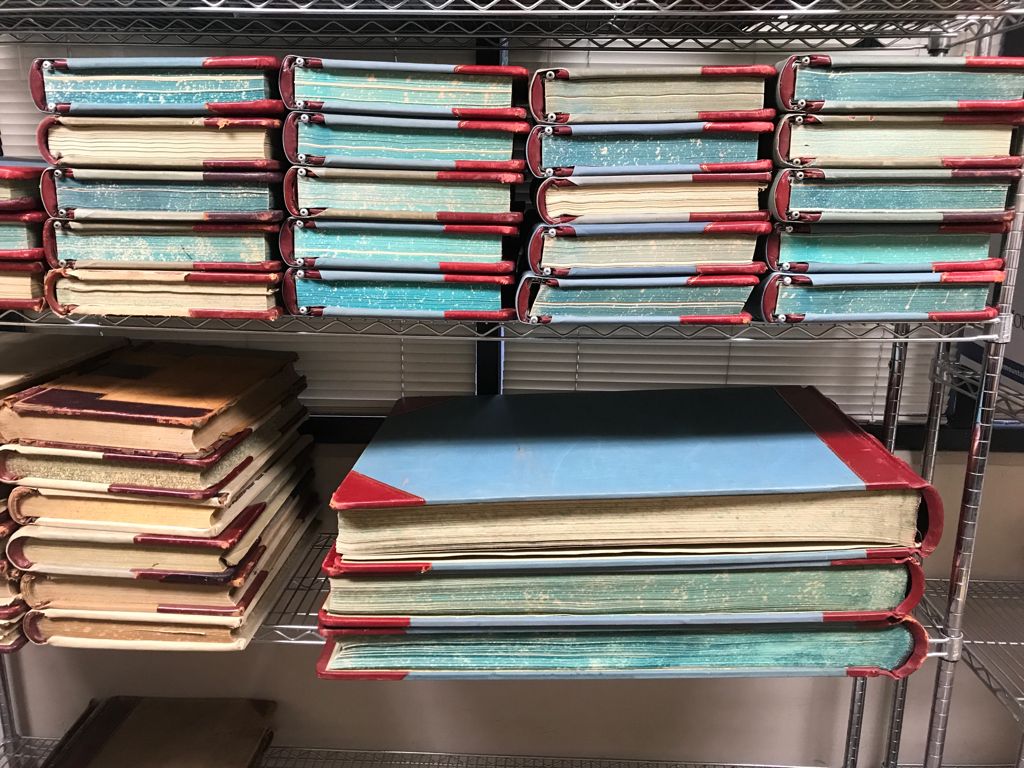
Why Digitize Lab Findings and Scientific Records: Explained
[boomdevs_toc]
Protecting valuable data and scientific research data is paramount.
Lab notebooks, filled with researchers’ notes, field study observations, sketches, and diagrams, hold a wealth of information that reflects countless hours of dedicated effort and intellectual endeavor. These notebooks are not just records; they are the intellectual property of researchers and institutions, deserving of the same level of protection as any critical business document.
Traditional paper lab notebooks, however, present several challenges. They can be fragile, susceptible to damage, and difficult to share or retrieve from archives. Recent studies have found that as much as 80% of the raw scientific data collected in the 1990s has been lost. The reasons? Insecure data storage and expired contact info for research authors.
This is where digitizing lab notebooks comes into play. Research and Development teams in industries like pharmaceuticals and life sciences can ensure their data is secure, easily accessible, and preserved for future use by converting these vital records into digital format.
Digitizing lab notebooks is a simple, cost-effective solution that addresses the vulnerabilities of physical records. It enhances data security, facilitates collaboration, and ensures that precious scientific insights are safeguarded against loss and deterioration.
The purpose of this blog is to provide a comprehensive look at the benefits and practicalities of digitizing lab notebooks for scientific research.
Traditional Lab Notebooks: Challenges and Limitations
Traditional paper lab notebooks have been a cornerstone of scientific research for decades, but they come with several significant drawbacks that can hinder scientific progress and data integrity.
1. Issues with Storage
- Paper notebooks require physical space for storage, which can be cumbersome and costly, especially for large research projects.
- Finding specific information in vast archives of paper notebooks can be time-consuming and inefficient.
2. Data Loss and Retrieval Difficulties
- Paper is susceptible to damage from environmental factors such as water, fire, and pests, which can lead to irreversible data loss.
- Misplaced or lost notebooks mean that valuable data might be irretrievable, posing a significant risk to ongoing research.
3. Lack of Collaboration Opportunities
- Sharing information stored in paper notebooks is challenging, especially when collaborating with remote teams.
- Manual entry and physical handling of notebooks can lead to errors and inconsistencies in data recording, further complicating collaborative efforts.
These challenges highlight the limitations of traditional lab notebooks and underscore the need for a more reliable and accessible solution. Digitizing lab notebooks addresses these issues by providing secure, easy-to-manage, and collaborative digital alternatives, ensuring that scientific data is well-protected and readily available for future research.
Why Lab Notebook Scanning & Scientific Records Digitization is Important?
Research notes, scientific findings, and field reports are critical intellectual assets for any organization. Just like business documents, these records must be protected diligently. Digitizing lab notebooks is a cost-effective and efficient solution to overcome the challenges associated with paper records.
Here’s why it’s important:
1. Prevent Data Loss
Handwritten documents and diagrams are fragile and susceptible to misplacement or loss, especially during long-term research projects with high employee turnover. Natural disasters such as hurricanes or floods can also destroy these vital records. Digitizing documents ensures that data is preserved through secure and efficient backups, preventing loss of information.
- Fragility of Paper: Paper deteriorates over time or is damaged due to environmental factors like moisture, heat, or pests. Digital copies do not degrade and are protected in the cloud.
- Misplacement and Loss: Paper notebooks can be misplaced, risking the loss of months or years of research. Digital backups ensure information remains intact and accessible.
- Employee Turnover: Handwritten notes might not transfer properly when researchers leave, creating data gaps. Digitized records are centrally stored and easily accessible to new team members.
- Natural Disasters: Events such as fires, floods, or earthquakes can obliterate paper records. Digital backups provide a haven for data, ensuring that research is not lost to unforeseen events.
2. Ensure Regulatory Compliance
Digitizing lab notebooks helps meet regulatory and industry standards. In fields like pharmaceuticals and life sciences, regulatory bodies require detailed documentation of all experiments and observations. Digital records make it easier to demonstrate compliance and maintain a verifiable history of research activities.
- Compliance Requirements: Many industries have stringent documentation requirements, including HIPAA compliance for handling sensitive health information. Digital records are easier to maintain and organize, ensuring compliance with these standards.
- Audit Readiness: Digital records are easily searchable and can be quickly retrieved for audits, reducing the time and effort required to demonstrate compliance.
- Data Security Protocols: Our scanning facility follows strict data security measures, including 24-hour surveillance, security alarms, smoke detection systems, and temperature control, to protect your documents.
- Secure Chain of Custody: We maintain a documented chain of custody, ensuring that your documents are tracked and protected from the moment they leave your premises until they are safely returned or digitized.
3. Facilitate Disaster Recovery
Paper-based records are vulnerable to damage from natural disasters, aging, or theft. Digitizing and storing them in a secure, cloud-based system provides a reliable backup that can be easily and affordably maintained. Even if physical archives are damaged, you’ll have electronic copies accessible from anywhere.
- Cloud Storage: Digital records stored in the cloud are protected from physical damage and can be accessed from any location.
- Automated Backups: Regular automated backups ensure that even recent changes to documents are preserved.
- Disaster Resilience: In the event of a natural disaster, having digital copies ensures that research can continue without significant disruption.
- Cost-effective Solutions: Cloud storage is a cost-effective method for maintaining backups, reducing the need for physical storage space and resources.
4. Enhance Data Validity
When publishing research findings, applying for patents, or undergoing audits, having trackable and auditable documentation is crucial. Digital records offer professional electronic documentation that can be shared with authorities as needed.
- Traceable Changes: Digital records can be easily audited, with a clear history of who accessed or modified the document and when.
- Proof of Authenticity: Electronic records can be encrypted and digitally signed to verify authenticity, ensuring that the data has not been tampered with.
- Easier Sharing: Digital files can be quickly shared with patent offices, regulatory bodies, and other authorities, speeding up the approval processes and reducing delays.
- Professional Presentation: Digitized documents present a more professional image, enhancing the credibility of the research.
5. Improve Collaboration
Long-term research and large field projects often require collaboration among colleagues, cross-functional teams, and external organizations. Handwritten records are difficult to share and manage. Digitized copies of documents facilitate seamless collaboration, allowing team members to access and work on the same documents easily.
- Real-time Collaboration: Digital platforms allow multiple users to work on the same document simultaneously, improving efficiency and coordination.
- Remote Access: Researchers can access digital notebooks from anywhere, enabling collaboration with team members in different locations or countries.
- Version Control: Digital documents can track changes and maintain version history, ensuring that all collaborators are working with the most up-to-date information.
- Centralized Repository: A centralized digital repository makes it easy for team members to find and use the necessary documents, reducing redundancy and improving productivity.
6. Faster Search and Retrieval
Research projects generate extensive volumes of information over time. Retrieving specific documents from physical archives can be time-consuming and inefficient. Digitized records enable instant searching and easy retrieval, streamlining research processes and saving valuable time.
- Instant Search: Digital documents can be indexed and searched by keywords, dates, or other criteria, allowing for quick retrieval of specific information.
- Efficiency: Researchers can find the necessary documents in seconds, rather than spending hours sifting through physical files.
- Reduced Errors: Digital search reduces the risk of human error in document retrieval, ensuring that researchers always find the correct information.
- Improved Organization: Digital files can be organized in a logical and easily navigable structure, making it simpler to manage large volumes of data.
7. Control Access to Confidential Data
Research findings and lab notes are sensitive and confidential. Physical notebooks are vulnerable to unauthorized access. Digitized documents, managed through a robust document management system, allow for strict access controls and user rights, ensuring only authorized personnel can view or edit the data.
- Access Control: Digital systems allow for precise control over who can access or modify documents, protecting sensitive information.
- User Rights Management: User permissions can be tailored to ensure that only authorized personnel have access to certain documents or sections.
- Audit Trails: Digital systems can record who accessed or modified a document and provide a clear audit trail for security and compliance purposes.
- Encryption and Security: Digital documents can be encrypted and stored securely, preventing unauthorized access and ensuring data confidentiality.
Digitizing your handwritten lab reports, scientific notebooks, and research notes not only secures your valuable data but also enhances accessibility and collaboration.
Contact us today to learn more about our lab notebook scanning services and protect your scientific research for the future.
What Document Scanning Companies Do to Protect & Preserve Your Research Notes & Lab Findings?
Ensuring the security and preservation of your lab notebooks and research findings is essential in safeguarding your valuable scientific work. The professional specialized digitization services provide a comprehensive solution to protect and digitize your lab records efficiently and securely. Here’s how we do it:
- Expert Lab Notebook Digitization Services – Digitizing your lab notebooks requires a service provider with the right experience and expertise. They offer tailored solutions to meet your specific needs, ensuring the integrity and quality of your digitized records.
- Tailored Scanning Solutions – Understanding the unique requirements of each lab notebook, our scanning technicians carefully assess your needs. They consider factors such as document size, binding type, cost, and image quality to provide the best service. For example, while grayscale scanning might be cost-effective, it is unsuitable for documents with colored diagrams or legends. Their approach ensures that your digital copies are both accurate and useful.
- Priority and Quick Turnaround Services – For researchers needing quick access to their records, they offer priority services with rapid turnaround times. Their onsite teams perform high-speed scanning to minimize downtime, ensuring that you receive your original notebooks back swiftly.
- Preserving Old and Fragile Records – Special care is taken with older and more fragile records. Their team meticulously prepares these documents by carefully removing pins, straightening folds, and covering areas that don’t require scanning. They also employ image correction software to enhance the clarity of the digital images, ensuring that even the most delicate documents are preserved accurately.
The Risks of Not Digitizing Your Lab Notebooks
In research settings, we often focus on digitizing the most immediately useful results, neglecting details that seem outside the core Research and Development program. While not ideal, this practice is common in Research and Development, where executives and managers prioritize key strategic outcomes in reports and overlook seemingly marginal notes. The challenge lies in identifying which observations will be valuable for future work.
Relying solely on experimental write-ups to digitize your data can jeopardize their long-term validity. For results to be reliable, experiments must be precise and reproducible. If not, the foundation of your research can be questioned. Theoretical risks are not the only concern. Physical lab notebooks are susceptible to theft, misplacement, disasters, and deterioration, risks that are exacerbated by employee turnover.
Even well-intentioned employees under contractual obligations may struggle to collect and organize all recorded information. At best, this leads to resource wastage. At worst, poor documentation can result in audit fines and jeopardize your company’s intellectual property.
Consider this scenario: Your company makes a significant discovery. An employee’s notebook is the legal proof of the who, how, where, and when. But if you can’t locate it, and your competition can prove their similar discovery—even if made later—you face patent infringement issues and a damaged reputation, losing rights to your breakthrough. The best way to avoid these risks?
Digitize everything in your lab notebook—the setups, diagrams, dates, and scribbles. Since manual digitization is impractical for busy researchers, partnering with a document scanning company in SF Bay is the optimal solution.
Choose a Lab Notebook Scanning Partner!
Given the serious implications of data loss, it’s evident that partnering with a document scanning company provides essential security and insurance for your research. However, not all document scanning partners offer the same level of service and expertise. Choosing the right scanning partner means selecting one with the proper tools and technology for the job.
At eRecordsUSA, we utilize advanced scanners that gently scan lab notebooks, research papers, and diagrams without breaking or cutting their bindings, especially in fields where this practice could be illegal. We produce crisp digital copies of every page, ensuring high-quality reproductions of your valuable documents.
Moreover, we understand that different organizations have unique preferences for their scanned images. While many clients prefer PDFs, our experienced team can deliver images in the format of your choice, whether through physical storage media or cloud-based document management platforms. We also tailor our bulk document scanning services to meet your specific needs, ensuring seamless integration with your existing workflows.
Lab professionals, Research and Development firms, and universities are inherently exposed to intellectual property risks due to the sensitive nature of their work.
Ready to secure and preserve your valuable scientific data? Discover the benefits of our lab notebook scanning services today. Our expert team at eRecordsUSA is here to help you protect your research, enhance collaboration, and ensure compliance with industry standards.
Contact us at (510) 900-8800 or email us at [email protected] to get started. Let’s take the first step towards safeguarding your scientific insights for the future!






